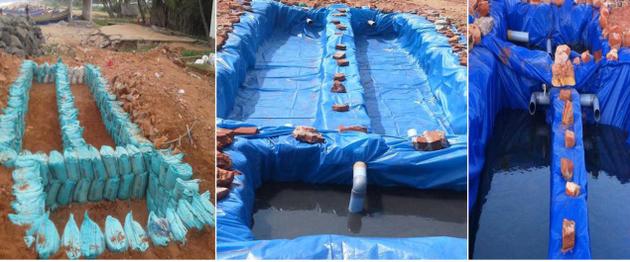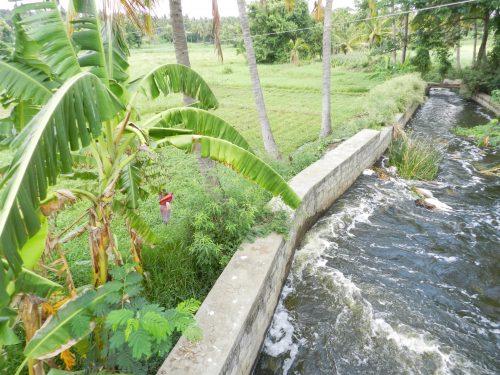This Low-Cost Technology Is Helping a Puducherry Village Treat Its Wastewater, and It Uses Plants!
A sleepy little village in Puducherry, Chinna Kalapet has embarked upon a journey of sustainable transformation by treating its wastewater the eco-friendly way.

In recent years, several Indian villages have embarked upon a journey of sustainable transformation that causes as little impact on the environment as possible. One such village is Chinna Kalapet in Puducherry, a sleepy little fishing hamlet that is setting an example by treating its wastewater the eco-friendly way.
Based on an innovative technology designed by Professor S.A. Abbasi from Pondicherry University, Chinna Kalapet’s low-cost wastewater treatment plant (called SHEFROL bioreactor) uses aquatic plants to absorb chemicals, pathogens and microorganisms from wastewater, making it fit for irrigation purposes.

Photo Source
In 2005, Prof. Abbasi was working to develop an eco-friendly, inexpensive, and simple technology for waste water treatment when he came up with the idea of SHEFROL (which stands for sheet flow root level). With the help of university colleagues, S Gajalakshmi and Tasneem Abbasi, he carried out several experiments to fine tune the technology before setting up a pilot plant on the university campus.
A SHEFROL plant treats wastewater using two aquatic plants – four leaf clover, and water hyacinth – that act as natural agents of phytoremdiation. Used for in-situ removal of contaminants in the environment, the term ‘phytoremediation’ comes from the Greek word for plants (‘phyto’).
You May Like: Bellandur Lake Fire: 5 Ways India Can Revive Its Polluted Urban Water Bodies
In this innovative system, the wastewater flows as a thin sheet through the roots of select aquatic plants in specially designed trenches made from plastic sheets. As the plants grow, thriving on the waste, they continuously detoxify the water. As a result of the intensive ‘water-root-microorganism’ contact made in these units, over 80 % of wastewater treatment is completed quickly (in about 2 hours) as compared to 2 days or more needed in other systems.
The treated, turbidity-free water can then be used for irrigation in farms and gardens. No foul smell emanates from the water treatment plant, which doesn’t use any kind of chemical. A simple system, it can be set up or dismantled easily as well as scaled up or scaled down as per need.

Photo Source
What also makes it a great option for villages, colonies or even large suburbs is the fact that it makes use of gravity and the topography, thus doing away with the requirement of pumping water. A small difference in fluid head between the inlet and outlet guarantees the constant flow of water in and out of the system.
With the cost of the pilot plant Prof. Abbasi set up on campus coming to only ₹ 600, SHEFROL also proved to be an inexpensive technology. Encouraged by its easy and efficient way of functioning, Pondicherry University soon set up SHEFROL plants in several places, in and around the campus.
SHEFROL was also certified as a novel and patentable technology after independent trials and tests were conducted on it by the Department of Science & Technology, Department of Biotechnology and Centre for Development of Advanced Computing.
In 2011, supported financially by the Department of Biotechnology, SHEFROL’s patent claim was registered and published in the Official Journal of The Patent Office, India. It remains undisputed.
In 2014, a SHEFROL plant was set up in Chinna Kalapet by PhD. student of Pondicherry University, Ashraf Bhat, as part of his thesis work with the guidance of Assistant Professor Tasneem Abbasi. Till then, water used to stagnate in the area where wastewater from the houses was let out, leading to the breeding of mosquitoes.

Photo Source
The SHEFROL plant was set up to remedy this civic problem. Every day, grey water (house-hold sewage) from 38 houses is fed into the plant that has a capacity of 10,000 litres. Costing only around ₹ 15,000, the plant consists of a sedimentation tank and channels created by sand bags placed in pits. This is covered by a non-permeable sheet that ensures wastewater does not seep into the ground as aquatic plants grow on top of it.
The low-maintenance plant (the villagers took just a day to learn how to operate and maintain it) takes only six hours to treat the wastewater, which is then used to irrigate a Casuarina plantation in the village.
The inventors of SHEFROL want more places in India to take up this robust, efficient and inexpensive green technology. They point out the fact that when compared to conventional wastewater treatment systems, SHEFROL has several advantages – a standard Sewage Treatment Plant costs around ₹50 lakh to set up and maintain whereas an eco-friendly SHEFROL plant of same capacity can be set up for as little as ₹ 20,000, with efficiency in both cases being almost similar!
Also, even though this technology has been patented, they are offering free transfer of technology to communities, just like how it has been done in Chinna Kalapet. Their team is also working to create a complete inventory of non-commercial aquatic plants that are commonly available in different regions of India. This will help in enabling the SHEFROL technology to be used anywhere.
Perfected over a period of 12 years, SHEFROL is an eco-friendly technology that may hold the answer to rural India’s wastewater management concerns. Sarvam, a Tamil Nadu-based NGO, is already working to install SHEFROL plants in several villages in the state while several European and Middle-Eastern nations have expressed their interest in implementing this system in their countries.
For details, click here.
Also Read: This Ecological Miracle in Kolkata Is Also the World’s Largest Organic Sewage Management System!
Like this story? Or have something to share? Write to us: [email protected], or connect with us on Facebook and Twitter.
NEW: Click here to get positive news on WhatsApp!

Similar Story

Startup’s Innovation Could Help Millions Get Access to Better Brain Health At Home
Ivory, a pioneering age-tech startup founded by Issac John and Rahul Krishnan, aims to redefine the ageing experience by focusing on better brain health, through neuroscience-backed assessments, interactive games, and personalised solutions.
Read more >
If you found our stories insightful, informative, or even just enjoyable, we invite you to consider making a voluntary payment to support the work we do at The Better India. Your contribution helps us continue producing quality content that educates, inspires, and drives positive change.
Choose one of the payment options below for your contribution-
By paying for the stories you value, you directly contribute to sustaining our efforts focused on making a difference in the world. Together, let's ensure that impactful stories continue to be told and shared, enriching lives and communities alike.
Thank you for your support. Here are some frequently asked questions you might find helpful to know why you are contributing?


This story made me
-
97
-
121
-
89
-
167












